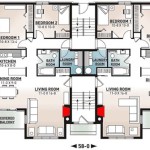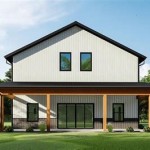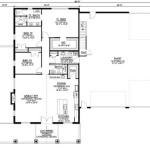Home Plans With Detached In-Law Suite: Balancing Independence and Proximity
The demand for adaptable housing solutions is steadily increasing. One such solution gaining significant traction is home plans incorporating a detached in-law suite. This architectural design offers a unique blend of independence and proximity, catering to multi-generational families, caregivers, or homeowners seeking rental income opportunities. Understanding the nuances of these plans, including their benefits, considerations, and design variations, is crucial for anyone contemplating this housing option.
Benefits of Detached In-Law Suites
The advantages of a detached in-law suite are multifaceted, addressing various needs and lifestyle preferences. The primary benefit lies in the provision of separate living spaces, allowing individuals to maintain their privacy and autonomy while remaining close to family or support networks. This is particularly appealing to aging parents or adult children returning home.
Independence is a key draw. Unlike attached suites or shared living arrangements, a detached unit offers a self-contained environment. Occupants have their own entrance, kitchen, bathroom, and living area, fostering a sense of ownership and control over their daily lives. This independence is vital for maintaining dignity and preventing feelings of being a burden, particularly for elderly family members.
Financial benefits also exist. Detached in-law suites can serve as rental units, generating passive income for the homeowner. This income can offset mortgage costs, fund retirement savings, or provide supplemental income for other expenses. The detached nature of the unit makes it more appealing to potential renters, as it offers enhanced privacy and a greater sense of independence compared to an attached unit.
Caregiving is another significant advantage. Having an in-law suite allows family members to provide care for aging relatives or individuals with disabilities while maintaining a degree of personal space and privacy. The proximity facilitates frequent check-ins and assistance with daily tasks, promoting peace of mind for all parties involved. This arrangement can delay or even prevent the need for assisted living facilities, preserving the family bond and reducing long-term care costs.
Finally, detached in-law suites increase property value. The addition of a fully equipped, separate living space enhances the overall appeal and marketability of the home. Potential buyers are drawn to the flexibility this design offers, catering to diverse lifestyles and future needs. The added square footage and independent functionality typically translate to a higher resale value compared to homes without such amenities.
Key Design Considerations for Detached In-Law Suites
Designing a detached in-law suite requires careful planning and consideration of various factors. The size, layout, and features of the unit should be tailored to the specific needs and preferences of the occupants, while also adhering to local building codes and zoning regulations. Accessibility is paramount, particularly if the suite is intended for elderly or disabled individuals.
Accessibility features may include ramps, wider doorways, grab bars in bathrooms, and roll-in showers. These modifications ensure that the space is safe and usable for individuals with mobility limitations. Universal design principles, which aim to create spaces that are accessible to people of all ages and abilities, should be incorporated throughout the design process.
Privacy is another important consideration. The placement of the suite on the property, the orientation of windows, and the use of landscaping can all contribute to creating a sense of seclusion and privacy for both the main house and the in-law suite. Soundproofing measures, such as insulated walls and windows, can further reduce noise transmission between the two structures.
Functionality is essential. The suite should include all the necessary amenities for independent living, including a fully equipped kitchen, a comfortable living area, a private bathroom, and a bedroom with ample storage space. The kitchen should be designed with ease of use in mind, with features such as pull-out shelves, adjustable countertops, and accessible appliances.
Energy efficiency is also a crucial aspect of the design. Implementing energy-saving features, such as solar panels, energy-efficient appliances, and proper insulation, can significantly reduce utility costs and minimize the environmental impact of the suite. These features not only benefit the occupants but also enhance the overall value and sustainability of the property.
Furthermore, consider the aesthetic integration of the suite with the existing home. The architectural style, materials, and colors should complement the main house, creating a cohesive and visually appealing property. This seamless integration enhances the curb appeal and prevents the suite from appearing as an afterthought or an isolated structure.
Variations in Detached In-Law Suite Plans
Detached in-law suite plans are available in a wide range of styles and configurations, catering to diverse preferences and property layouts. The size, shape, and features of the suite can be customized to meet the specific needs of the occupants and the constraints of the building site. Understanding the different variations can aid in selecting the most suitable plan.
One common variation is the converted garage or outbuilding. Existing structures, such as detached garages, sheds, or workshops, can be remodeled into fully functional in-law suites. This approach can be more cost-effective than building a new structure from scratch, particularly if the existing building is structurally sound and properly insulated. However, careful planning is required to ensure that the converted space meets all building codes and provides adequate living space.
Another popular option is the modular or prefabricated in-law suite. These units are constructed off-site in a factory and then transported to the property and assembled on a foundation. Modular homes offer several advantages, including faster construction times, lower costs, and greater control over the manufacturing process. They are also available in a variety of styles and floor plans, making it easier to find a design that fits the homeowner's needs and aesthetic preferences.
Custom-designed in-law suites offer the greatest flexibility, allowing homeowners to create a space that is perfectly tailored to their specific requirements. This approach involves working with an architect or designer to develop a unique plan that incorporates all the desired features and amenities. Custom designs can be more expensive and time-consuming than other options, but they ensure that the finished product is exactly what the homeowner envisioned.
Accessory Dwelling Units (ADUs) are a broader category that includes detached in-law suites. ADUs are self-contained residential units located on the same property as a single-family home. Local regulations governing ADUs vary widely, so it is essential to research the specific requirements in your area before proceeding with any construction or remodeling projects. Some jurisdictions have relaxed their ADU regulations in recent years to encourage the development of more affordable housing options.
Finally, consider the layout of the suite. Open-concept designs, which combine the kitchen, living room, and dining area into a single spacious room, are popular for their modern aesthetic and efficient use of space. However, some occupants may prefer a more traditional layout with separate rooms for greater privacy and sound control. The choice between an open-concept and a traditional layout depends on the individual preferences of the occupants and the overall design goals of the project.
In conclusion, detached in-law suites provide a viable solution for accommodating multi-generational families, providing caregiver support, or generating rental income. Careful consideration of the benefits, design elements, and various plan options is essential for maximizing the potential of this adaptable housing arrangement. Thorough research and consultation with qualified professionals can ensure the successful implementation of a detached in-law suite that effectively meets the needs of all parties involved.

Homes With Mother In Law Suites

House Plans With In Law Suites Houseplans Blog Com

In Law Suite Plans Give Mom Space And Keep Yours The House Designers

Country House Plan With 4 Bedrooms And 3 5 Baths 4427

Plan 65862 Tuscan Style House Floor Plans With 2091 Sq Ft 3 Be

Exclusive 4 Bed House Plan With Detached In Law Suite 93109el Architectural Designs Plans

One Story With In Law Suite Plan 2286

House Plans With In Law Suites Houseplans Blog Com

Arts And Crafts Country Home With 5 Bedrms 2473 Sq Ft Plan 108 1692

So I Have A Project Where Am Designing Main House And An Attached Mother In Law Suite The Is Guest Plans Family








